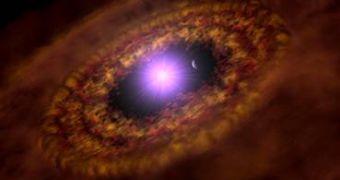Compared to the age of our own planet, the Earth, which is about 4.5 billion years old, the newly discovered exoplanet is a baby, estimated to be somewhere between 8 to 10 million years old and orbiting a star very similar to the Sun. Expect no further resemblance to our solar system however, as the new exoplanet has a mass at least ten times that of the planet Jupiter, circling its sun once every 3.56 days.
Located at a distance of about 180 light years away from Earth in the Hydrae constellation, TW Hydrae b has a orbit radius of only 4 percent of that of the Earth around the Sun. This it the youngest planet ever discovered, since the observation of the first exoplanet nearly twelve years ago, that revealed planets at least 100 million years old.
TW Hydrae b is indeed extremely young, so young in fact that the protoplanetary disk circling the star hasn't been cleared up by forming planets yet, proving the predictions of the current theory regarding the planetary formation models that states that planets must be able to form in a period as short as 10 million years, before the stellar radiation and solar wind has time to dissipate the protoplanetary disk in order to inhibit the planet formation process.
Furthermore, though evidence of young planets forming around young stars has been previously found, astronomers were not able to view the actual planet but only the trails of its passing through the massive gas and dust cloud, left behind as it scoops part of the material in its path around the star, such as clear lanes inside the protoplanetary disks.
The new exoplanet was discovered by Johny Setiawan from the Max-Plank Institute for Astronomy in Germany, through a traditional method which involved detecting the wobble of the mother star, produced by the gravitational pull of the planet. Nevertheless, though it is a widely used detection method, sometimes it can lead to false discoveries suggesting that a planet is present in the near vicinity of the star, when, in fact, the effect in produced by another class of objects or phenomena.
For example, in such a young solar system, the newly born star is incredibly active causing matter fluctuations in its atmosphere, that contributes to the appearance of parasite signals, which are greatly amplified further if the star is spinning around its axis.
Young solar systems are especially important in astrophysics studies, as not all of the processes taking place during planetary formation are well known. Planets are thought to form in the protoplanetary disks spinning around new-born stars, thus, finding such planets inside such structures can provide with important information about how they actually form.

 14 DAY TRIAL //
14 DAY TRIAL //